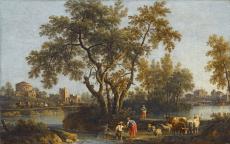


Although he was born in the Lombard town of Salò, near Brescia, and trained in Brescia and Bologna, Giovanni Battista Cimaroli settled in Venice in 1713 at the age of 26. There he married the sister-in-law of his master, the Veronese battle painter Antonio Calza (1658-1714), and, as far as we know, remained for the rest of his long career. Cimaroli’s most impressive works are his views, although only about 20 of those have been identified, mainly of Venice, although Dolo and Verona also feature. Most have at one time or another been attributed to Canaletto (1697-1768), including the very large view of The Piazza San Marco with the Populace Chasing Bulls in Celebration of the Visit of Friedrich Christian of Saxony, 16 February 1740 (England, private collection), purchased in Venice in 1836 as by Canaletto and first published in 2010; Dolo on the Brenta (Stuttgart, Staatsgalerie), which was as recently as 1989-1990 included in the great Canaletto exhibition in New York; and a view of The Grand Canal at the Entrance to the Cannaregio (Venice, private collection), of which the Canaletto scholar W. G. Constable wrote, ‘The greater part of the painting is undoubtedly by Canaletto; but some of the figures […] may be by another hand.’ Cimaroli’s work was occasionally mistaken for Canaletto’s even by contemporaries, quite possibly deliberately. A smaller variant of The Piazza San Marco with the Populace Chasing Bulls (Italy, private collection) was in the collection of Bouchier Cleeve (1715-1760) at Foot’s Cray Place, Kent, as the work of ‘Canaletti and Chimeroli’. Despite the unlikelihood of such a collaboration between the two artists, this dual attribution was retained by Constable and is still accepted in some quarters to this day.
These view paintings were probably all produced in the 1730s and 1740s in response to the popularity of those by Canaletto, Cimaroli’s junior by ten years, and in direct competition with the already famous younger artist. It was presumably to works in this genre that the prominent Swedish politician and connoisseur Count Carl Gustav Tessin referred in a letter of 16 June 1736 in which he listed Cimaroli immediately after Canaletto, noting that, ‘[…] he paints in the same taste, but has not yet arrived at the top of the ladder, moreover spoiled by the English, who have imagined that the smallest of his paintings is worth 30 zecchini’. Indeed, the patron and collector Marshal Johann Matthias von der Schulenburg, a Venetian resident, paid Cimaroli 50 zecchini for a pair of views of the Dogana and the Carità in 1736, the same year that he paid the same sum to Michele Marieschi (1710- 1743), for his large and exceptional Courtyard of the Doge’s Palace (Italy, private collection); and Canaletto’s masterpiece The Riva degli Schiavoni, Looking West (London, Sir John Soane’s Museum), also commissioned in the same year, might seem a relative bargain at 120 zecchini.
Despite his successes as a view painter, Cimaroli was most active as a landscapist and returned to this genre after his brief outing into the field of view painting. He has a good claim to having been the leading native Venetian landscape artist after the death of Marco Ricci (1676-1730), since his leading competitor, Francesco Zuccarelli (1702-1788), to whom the A. G. Leventis Collection paintings were attributed in the sale room in 1962, was of Tuscan origin. His distinctive and elegant works in this genre have always been admired and ensured his inclusion in most general studies of 18th-century Venetian painting even before the extent of his activity as a view painter came to be recognised.
Cimaroli’s reputation as a landscape painter was such by 1722 that he received the prestigious commission to collaborate with other carefully selected painters on no fewer than four of the ‘Allegorical Tombs’ series commissioned by the Irish impresario Owen McSwiny, including both of those to which Canaletto contributed the architectural element, that of Lord Somers with figures by Giovanni Battista Piazzetta (1682/3- 1754), and that of Archbishop Tillotson with figures by Giovanni Battista Pittoni (1687-1767). Of his bucolic pure landscapes, influenced by Marco Ricci, two were owned by Schulenburg and no fewer than six by Joseph Smith. Presumably many were exported, and the early 19th-century(?) inscription in Italy on a label on the stretcher of the Leventis Collection landscape suggests that the pair may have arrived in England at an early date. Cimaroli also painted a number of imaginary views of towns and villages on the Brenta, which are indeed his most original subject matter.
Despite the convincing – and often very detailed – descriptions which these provide, these are presumably as imaginary as his landscapes, products of the imagination being more highly prized by local contemporaries than reproductions of reality. It may be noted, however, that one of the pair acquired by Henry howard, 4th Earl of Carlisle, presumably on his visit to Venice on the Grand Tour in 1738-1739 and now in the Fondazione Terruzzi, Bordighera, was described as a view of Mira when it was sold from Castle Howard in 1922.
Although he was born near Brescia and studied there and in Bologna, he settled in Venice in 1713 and married the sister-in-law of his master, Antonio Calza; as far as is known, he remained there for the rest of his life. His most impressive works are his view paintings, mainly of Venice, which have often been attributed to his competitor, Canaletto. He was more productive as a landscape painter and created several imaginary views of towns and villages on the Brenta River.